On August 13, 2018, the Office of Management and Budget released President Trump’s so-called “signing statement” accompanying H.R. 5515, the National Defense Authorization Act (NDAA) for fiscal year 2019. In a week packed with plenty of news on other topics, this signing statement managed to garner quite a bit of attention because the president is laying down a marker against more than fifty provisions in the NDAA.
Signing statement are not new – Presidents Bush used them extensively, and President Obama issued some as well. But unlike a veto, there is no constitutional provision for signing statements. A signing statement is often an indication of the provisions of an act that the president may choose to ignore or reject outright. So these documents are much in demand for the kind of tea-leaf-reading that occupies many minds in Washington.
This signing statement, however, was unusually opaque in that it listed only the section numbers under each of the six different grounds the president cites for his objections. So, as a public service to our fellow tea-leaf-readers, at TCS we took the time to track down every single section number the president finds objectionable and add the title of that section.
Below, please find your roadmap to the president’s objections. We’ll be delving into the particulars and looking to see if any of them bear more analysis. Until then, enjoy the TCS version of the Cliff Notes.
Objected to on grounds they “purport to restrict the President’s authority to control the personnel and material the President believes to be necessary or advisable for the successful conduct of military missions”:
- Section 112: Deployment by the Army of an interim cruise missile defense capability.
- Section 147: Limitation on availability of funds for retirement of E-8 JSTARS Aircraft
- Section 936: Responsibility for policy on civilian casualty matters.
- Section 1017: Limitation on use of funds for retirement of hospital ships.
- Section 1665: Prohibition on reduction of the intercontinental ballistic missiles of the United States.
- Section 1689: Acceleration of hypersonic missile defense program.
Objected to because they “require that the Congress receive a certification or notification before the President directs certain military or diplomatic actions.”
- Section 141: Inventory requirement of air refueling tanker aircraft; limitation on retirement of the KC-10A
- Section 147 (again): Limitation on availability of funds for retirement of E-8 JSTARS Aircraft
- Section 323: Limitation on length of overseas forward deloyment (sic) of naval vessels.
- Section 1231: Extension and modification of authority to provide assistance to the vetted Syrian opposition.
- Section 1242: Limitation on availability of funds relating to implementation of the Open Skies Treaty.
- Section 1247: Extension on limitation on military cooperation between the United States and the Russia Federation.
- Section 1259: Prohibition on participation of the People’s Republic of China in Rim of the Pacific (RIMPAC) naval exercises.
- Section 1264: Limitation on the use of funds to reduce the total number of members of the Armed Forces serving on active duty who are deployed to the Republic of Korea.
- Section 1290: Certifications regarding actions by Saudi Arabia and the United Arab Emirates in Yemen.
Objected to because they violate “constitutional separation-of-powers principles, including the President’s constitutional authority as Commander in Chief.”
- Section 1033: Prohibition on use of funds for transfer or release of individuals detained at United States Naval Station, Guantanamo Bay, Cuba, to the United States.
- Section 1035: Prohibition on use of funds for transfer or release of individuals detained at United States Naval Station, Guantanamo Bay, Cuba, to certain countries.
Objected to because they, “dictate the position of the United States in external military and foreign affairs.”
- Section 1207: Participation in and support of the Inter-American Defense College.
- Section 1241: Prohibition on availability of funds relating to sovereignty of the Russian Federation over Crimea.
- Section 1257: Strengthening Taiwan’s force readiness.
- Section 1289: Coordination of efforts to negotiate free trade agreements with certain sub-Saharan African countries.
Objected to because of, “concerns under the Constitution’s Appointments Clause and the separation of powers.”
- Section 739: Increase in number of appointed members of the Henry M. Jackson Foundation for the Advancement of Military Medicine.
- Section 1051: National Security Commission on Artificial Intelligence.
Objected to because they, “mandate or regulate the submission to the Congress or the publication of information protected by executive privilege.”
- Section 595: Public availability of top-line numbers of deployed members of the Armed Forces.
- Section 842: Removal of national interest determination requirements for certain entities.
- Section 1031: Definition of sensitive military operation.
- Section 1043: Coordinating United States response to malign foreign influence operations and campaigns.
- Section 1062: Improvement of annual report on civilian casualties in connection with United States military operations. (President states he will interpret this as, “requiring only the submission of information that is reasonably available to DOD, not as requiring changes in the underlying processes for battle damage assessment and investigation.”)
- Section 1212: Legal and policy review of advice, assist, and accompany missions.
- Section 1231: Extension and modification of authority to provide assistance to the vetted Syria opposition.
- Section 1233: Extension of authority to provide assistance to counter the Islamic State of Iraq and Syria.
- Section 1236: Modification to annual report on the military power of Iran.
- Section 1245: Report on implementation of the New START Treaty.
- Section 1262: Report on military and coercive activities of the People’s Republic of China in South China Sea.
- Section 1265: Reports on nuclear capabilities of the Democratic People’s Republic of Korea.
- Section 1274: Review to determine whether the Armed Forces or coalition partners of the United States violated Federal law or Department of Defense policy while conducting operations in Yemen.
- Section 1280: Report on permanent stationing of United States forces in the Republic of Poland.
- Section 1281: Report on strengthening NATO cyber defense.
- Section 1287: Report on Honduras, Guatemala, and El Salvador.
- Section 1294: Modified waiver authority for certain sanctionable transactions under section 231 of the Countering America’s Adversaries Through Sanctions Act.
- Section 1761: Enforcement (related to Committee on Foreign Investment in the United States Title, aka CFIUS, of the act.)
Objected to on the grounds they, “require executive branch officials under the President’s supervision to recommend certain legislative measures to the Congress.”
- Section 218: National Defense Science and Technology Strategy.
- Section 327: Report on pilot program for micro-reactors.
- Section 335: Report on optimizing surface Navy vessel inspections and crew certifications.
- Section 627: Study and report on development of a single defense resale system.
- Section 1018: Inclusion of aircraft carrier refueling overhaul budget request in annual budget justification materials.
- Section 1065: Limitation on use of funds for United States Special Operations Command Global Messaging and Counter-Messaging platform
- Section 1205: Review and report on processes and procedures used to carry our section 362 of title 10, United States Code.
- Section 1208: Naval Small Craft Instruction and Technical Training School.
- Section 1261: United States strategy on China.
- Section 1677: Extension of requirement for reports on unfunded priorities of Missile Defense Agency.
- Section 1793: Review of and report on certain defense technologies critical to the United States maintaining superior military capabilities.











Get Social